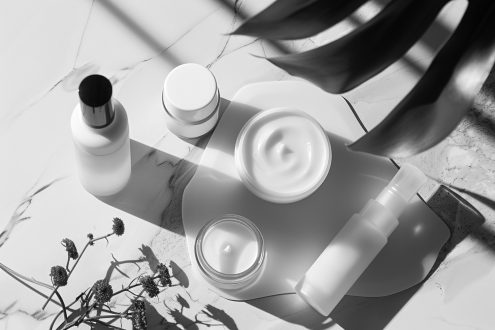- Empty cart.
- Continue Shopping
How to Navigate Product Liability Insurance for Skincare Brands
How to Navigate Product Liability Insurance for Skincare Brands
Product liability insurance is essential for skincare brands, as it protects against potential claims that may arise if a product causes harm to customers. Understanding how to navigate this insurance can help you safeguard your business and build trust with your customers. Here’s a guide on securing and managing product liability insurance for your skincare brand.
1. Understand What Product Liability Insurance Covers
- Why It Matters: Product liability insurance provides coverage in case your products cause injury, allergic reactions, or damage to property, protecting your business from costly legal claims.
- How It Works: This insurance typically covers legal fees, medical costs, and compensation for damages if a customer experiences harm from using your products. Skincare brands are especially susceptible to liability because skincare products are used on sensitive areas like the face and body.
Tip: Ensure the policy covers all possible claims, including those related to allergic reactions, contamination, and mislabeling.
2. Assess Your Risk Level
- Why It Matters: Different skincare products carry different levels of risk, which can affect your insurance needs and premiums.
- How It Works: Higher-risk products, such as those with active ingredients (e.g., retinoids or acids), may require more comprehensive coverage due to the increased likelihood of adverse reactions. Assessing your product line will help you determine the appropriate level of coverage.
Tip: Work with your insurance provider to evaluate risk factors, including ingredients, formulations, and intended use.
3. Choose the Right Insurance Provider
- Why It Matters: Not all insurance providers specialize in skincare or cosmetics, so finding a provider familiar with the industry ensures tailored coverage.
- How It Works: Look for providers that offer product liability insurance specifically for beauty, skincare, or wellness brands. A provider with industry expertise will understand the unique risks involved and can guide you in selecting the right policy.
Tip: Seek recommendations from other skincare businesses, or consult industry groups to find reputable insurers.
4. Understand Coverage Limits and Exclusions
- Why It Matters: Knowing the limits and exclusions of your policy helps avoid unexpected costs and ensures that your business is fully protected.
- How It Works: Coverage limits determine the maximum amount the insurer will pay per claim or per year, while exclusions outline circumstances not covered. Typical exclusions may include damage from customer misuse or product recalls.
Tip: Read the fine print carefully and discuss any questions with your insurer to ensure clarity on coverage details.
5. Decide on Additional Coverage if Needed
- Why It Matters: Depending on your business model, additional coverage may be necessary to protect against other risks beyond product liability.
- How It Works: In addition to product liability insurance, you may need general liability insurance, which covers accidents on your premises, and professional liability insurance if you provide personalized skincare advice. Combining policies often results in more comprehensive protection.
Tip: Ask your provider about bundling options to cover all aspects of your business under one plan, potentially saving on premiums.
6. Document Product Testing and Compliance
- Why It Matters: Documentation of product safety testing and compliance can support your case if a liability claim arises, and some insurers may require it.
- How It Works: Keep records of ingredient sourcing, batch testing, and compliance with regulations, such as FDA guidelines or EU safety standards. Thorough documentation demonstrates your commitment to safety and may help in securing lower premiums.
Tip: Maintain an organized record-keeping system to store testing, formulation, and compliance documentation for easy reference.
7. Establish Clear Product Labels and Warnings
- Why It Matters: Accurate labeling helps protect your business from claims by providing clear usage instructions and potential allergen warnings.
- How It Works: Include directions for use, ingredient lists, allergy warnings, and precautionary statements on product packaging. This transparency informs customers and may prevent potential misuse or allergic reactions.
Tip: Work with a labeling specialist or legal advisor to ensure compliance with all relevant regulations and clarity for the customer.
8. Implement a Quality Control Process
- Why It Matters: Consistent quality control reduces the risk of defective products reaching customers, which can lead to fewer liability claims.
- How It Works: Establish procedures for regular quality checks, batch testing, and monitoring of production processes. Identify and correct issues before products are shipped, demonstrating a commitment to safety and quality.
Tip: Document your quality control procedures as part of your risk management strategy to help support any potential claims.
9. Maintain Customer Complaint Records
- Why It Matters: Tracking complaints helps identify recurring issues and allows you to address potential risks before they escalate.
- How It Works: Set up a system for recording customer complaints and follow up promptly. If a particular product or ingredient repeatedly causes issues, consider revisiting the formulation or adding an additional warning label.
Tip: Use feedback from customer complaints to refine products and show insurers your proactive approach to risk management.
10. Review and Renew Your Policy Regularly
- Why It Matters: Your insurance needs may change as your product line expands, ingredients change, or business grows, so regular reviews ensure your coverage remains adequate.
- How It Works: Schedule annual reviews of your policy to ensure it reflects any changes in your business. Notify your insurer if you introduce new products or make significant updates to formulations, as these may impact your risk level and coverage needs.
Tip: Make policy reviews part of your annual business planning to ensure you’re always adequately covered.
11. Prepare for the Claims Process
- Why It Matters: Understanding the claims process can help minimize disruptions to your business if a liability claim is filed.
- How It Works: If a claim arises, document the incident carefully, report it promptly to your insurer, and provide all requested documentation. Familiarize yourself with the steps involved, such as filing forms, submitting evidence, and responding to follow-up inquiries.
Tip: Work closely with your insurer to navigate the claims process smoothly and minimize impact on your operations.
Key Benefits of Product Liability Insurance for Skincare Brands
- Financial Protection: Coverage for legal fees, medical expenses, and compensation minimizes financial loss.
- Customer Trust: Knowing you are insured shows customers that you prioritize safety and quality.
- Risk Management: Insurance, combined with proper labeling and quality control, reduces the impact of potential issues.
- Peace of Mind: Adequate coverage provides security, allowing you to focus on growing your business confidently.
Conclusion: Protecting Your Skincare Brand with Product Liability Insurance
Product liability insurance is a crucial safeguard for skincare brands, helping protect against the financial risks of liability claims. By understanding your coverage, working with an experienced insurer, and implementing thorough quality control, you can minimize risks and reassure customers of your commitment to safety. With the right coverage in place, your skincare brand can focus on growth and innovation with peace of mind.
Interested in creating your own product line? Explore our private labeling options and bring your brand vision to life. Fill out our Form to get started.
Discover more about our services by visiting our website.

